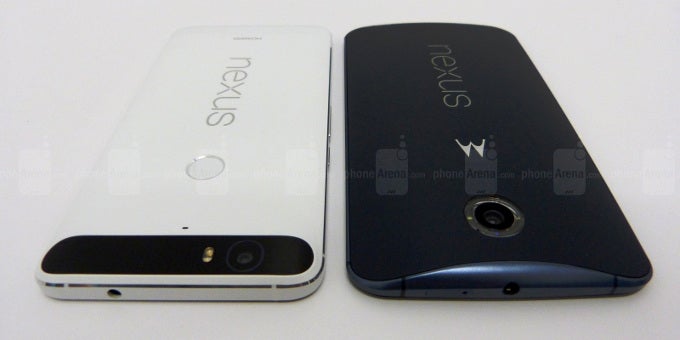Should you upgrade from the Google Nexus 6 to the Nexus 6P

The Nexus 6P is now official, grabbing the phablet banner straight from the hands of last year's Nexus 6. Still, does the new top phablet in vanilla Androidland boast enough improvements and new features to make an upgrade worth it? Do the new design and improved specs sheet mean that Nexus 6 should run wild to the Google Store and order Huawei's first crack at making a Nexus smartphone as fast as they possibly can? We will try to answer these questions for you in the paragraphs right below.
This category is a pretty tricky one. Google decided that Qualcomm's top-tier Snapdragon 810 v2.1 should make the cut inside the Nexus 6P. By this time, you're probably familiar with all the fuzz around this chipset, which has been plagued by a host of overheating issues, but we digress. The 64-bit octa-core chip on the Nexus 6P is clocked at 2.0GHz and has an Adreno 430 GPU on board.
There's a 3,450mAh battery unit inside the Nexus 6P, which is bigger than the 3,220mAh one at the rear of the Nexus 6. Is this a reason for upgrading? Well, most probably yes, but we will need to put the new entrant through our battery benchmark test in order to see how it stacks up against its predecessor. As a refresher, the Nexus 6 endured for 7 hours and 53 minutes in our battery life test, which is a solid achievement. This result keeps our hopes for the Nexux 6P high.
Let us throw some raw specs at you: the Nexus 6P comes with a 12.3MP camera at the back that is most likely toting a 1/2.3" Sony IMX377 sensor that has f/2.0 lens and 1.55-micron pixels that . Interestingly enough, it seems that this sensor is intended for compact point-and-shoot cameras. It shoots 4K videos and 240fps slo-mo videos, which are pretty compelling functionalities that heavily tip the scales in favor of the device. The camera also comes with laser-assisted auto-focus. All things considered, we have pretty high expectations for the shooter on the Nexus 6P. The Nexus 6, which comes with a 13MP camera that has an aperture of f/2.0, performed very good, but it seems that the Nexus 6P will give it a pretty serious run for the money.
Тhe Nexus 6P has a killer feature that the Nexus 6 is devoid of - a fingerprint scanner at the rear that is always in standby mode. Thanks to it, you can unlock and wake your phone by simply placing your finger on the scanner, without having to press the power button or do anything else. Of course, this is not the sole purpose of the reader - it's also going to open the gates before Android Pay, Google's mobile payment system.
Design
The two devices come with vastly different exterior looks. The Nexus 6 employs an arched plastic casing at the back and a metal frame on the sides. In the meantime, the Nexus 6P employs a svelte all-metal exterior that features aircraft-grade aluminum. Favoring one over the other judging by the exterior design will be mostly a matter of one's personal preference. Personally, we feel like that the Nexus 6P might have a more premium feel than its predecessor. If design and design alone is of utmost importance to you, then the Nexus 6P could easily score a point over its predecessor.
In terms of size, the Nexus 6P is a smidgen taller than the Nexus 6, yet not as wide and a bit thinner. However, the Nexus 6P has worse screen-to-body ratio - 71.77% vs 74.03%. This means that the older Android champ is more efficient in terms of utilizing that front real estate. Additionally, both are not that much different in terms of weight. In this category, we feel like the two are pretty much tied.
Additionally, the Nexus 6P comes with a USB Type-C connector at the bottom. A suitable cable is supplied in the box. Bottom line: Тhe aluminum Nexus 6P comes with arguably better design than the Nexus 6; it's also narrower, thinner, and lighter. Also - USB Type-C aboard.
Display
The Nexus 6P has a 5.7-inch AMOLED display with a resolution of 1440 x 2560 pixels, while the Nexus 6 is equipped with a 6-inch screen boasting the same resolution, which is also of the AMOLED kind. Of course, this means that the new Nexus has a sharper display than its predecessor (518ppi vs 493ppi), which is a differentiating feature that might not be easily discernible by the untrained, naked eye, but still deserves a mention. Both displays are protected by Gorilla Glass, but the Nexus 6P boasts Gorilla Glass 4, while the Nexus 6 - Gorilla Glass 3. That said, if the screen estate is important to you, you will probably be reluctant to switch to the 6P.
Processor and memory
This category is a pretty tricky one. Google decided that Qualcomm's top-tier Snapdragon 810 v2.1 should make the cut inside the Nexus 6P. By this time, you're probably familiar with all the fuzz around this chipset, which has been plagued by a host of overheating issues, but we digress. The 64-bit octa-core chip on the Nexus 6P is clocked at 2.0GHz and has an Adreno 430 GPU on board.
Being the revised v2.1 version, the chipset inside should theoretically be putting the kibosh on all overheating issues, but we can't say whether this is true or not just yet. The Nexus 6, on the other hand, comes forth with a Snapdragon 805, which is not the creme de la creme anymore, but is still a potent chipset that performs well if you don't push it just too hard. The one in the Nexus 6 is a quad-core one clocked at 2.7GHz.
What's our verdict in this category? All things considered, we are inclined to go for the Snapdragon 810 due to the future-proof haze flowing around it.
Battery
There's a 3,450mAh battery unit inside the Nexus 6P, which is bigger than the 3,220mAh one at the rear of the Nexus 6. Is this a reason for upgrading? Well, most probably yes, but we will need to put the new entrant through our battery benchmark test in order to see how it stacks up against its predecessor. As a refresher, the Nexus 6 endured for 7 hours and 53 minutes in our battery life test, which is a solid achievement. This result keeps our hopes for the Nexux 6P high.
Yet, do have in mind that the Nexus 6P doesn't come with wireless charging on board, while the Nexus 6 does.
Camera
Let us throw some raw specs at you: the Nexus 6P comes with a 12.3MP camera at the back that is most likely toting a 1/2.3" Sony IMX377 sensor that has f/2.0 lens and 1.55-micron pixels that . Interestingly enough, it seems that this sensor is intended for compact point-and-shoot cameras. It shoots 4K videos and 240fps slo-mo videos, which are pretty compelling functionalities that heavily tip the scales in favor of the device. The camera also comes with laser-assisted auto-focus. All things considered, we have pretty high expectations for the shooter on the Nexus 6P. The Nexus 6, which comes with a 13MP camera that has an aperture of f/2.0, performed very good, but it seems that the Nexus 6P will give it a pretty serious run for the money.
It's also important to note that the Nexus 6 comes with optical image stabilization, whereas the Nexus 6P doesn't, so have that in mind.
At the front, the situation is rather different - the Nexus 6P has an 8MP selfie shooter, while the older Nexus phablet merely a 2MP one. Naturally, this warrants more detailed selfies. In case you are a selfie addict, this is a pretty solid reason for upgrade. Although we can't give a clear verdict whether you should upgrade if you're looking for a Nexus phone with a better camera, it seems that the Nexus 6P might end up pleasantly surprising us.
Fingerprint scanner
Тhe Nexus 6P has a killer feature that the Nexus 6 is devoid of - a fingerprint scanner at the rear that is always in standby mode. Thanks to it, you can unlock and wake your phone by simply placing your finger on the scanner, without having to press the power button or do anything else. Of course, this is not the sole purpose of the reader - it's also going to open the gates before Android Pay, Google's mobile payment system.
The final verdict: should you upgrade?
As usual, it largely depends. If the looks of the Nexus 6P, its slimmer aluminum design, improved front and rear cameras, fingerprint scanner, and larger battery are successfully grabbing your attention, then you should probably consider upgrading from your Nexus 6. Still, the latter is a rather adequate device even in this day and age - hence, it's perfectly normal to not feel any need to upgrade just yet.
Yet, we feel like the Nexus 6P has enough compelling new features to successfully succeed the Nexus 6. If you feel the same way, prices start from $499 for the 32GB version, while the 64 and 128GB version will cost you $549 and $649, respectively.













Things that are NOT allowed: